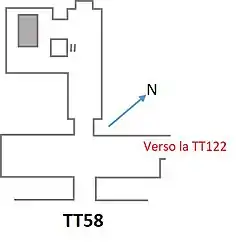| Theban tomb TT58 | |
|---|---|
| Burial site of Courtier, and usurped by Amenhotep and Amenemonet | |
 | |
| Location | Sheikh Abd el-Qurna, Theban Necropolis |
The Theban Tomb TT58 is located in Sheikh Abd el-Qurna, part of the Theban Necropolis, on the west bank of the Nile, opposite to Luxor. The tomb was originally carved for a courtier dating to the time of Amenhotep III and later usurped during the Ramesside period.[1]
Tomb
The tomb was originally made for a courtier from the time of Amenhotep III during the 18th Dynasty. In the hall there is still a scene with the original owner appearing before Amenhotep III and the goddesses Hathor. Another scene shows the original owner and his wife with squatting divinities before Amenhotep III and Maat in a kiosk. Prostrate Syrians are depicted on the base of the kiosk.[1]
| Amenhotep in hieroglyphs | ||||
|---|---|---|---|---|
| Era: New Kingdom (1550–1069 BC) | ||||
| Amenemonet in hieroglyphs | |||||
|---|---|---|---|---|---|
| Era: New Kingdom (1550–1069 BC) | |||||
The tomb was usurped during the 19th or 20th Dynasty by a man named Amenemonet and his father Amenhotep.[1]
Amenemonet (the son) is a scribe of the Sacred Offerings of Amun, Temple Scribe of Mut, and Scribe in the Temple of Ramesses II, "Beloved like Amun". Amenemone is accompanied by his wife Henutanensu. Amenemone's father Amenhotep was an Overseer of the prophets of Amun.[2]
The hall of the tomb is decorated with scenes from the Book of Gates and the Book of the Dead. One of the texts mentions King Ramesses I.[1] A scene from the tomb, now in the Cairo museum (JE 43591) depicts Amenemonet before the sacred bark of Amun. Amenemonet is shown accompanying the Vizier Paser.[3]
See also
References
- 1 2 3 4 5 6 Porter and Moss, Topographical Bibliography: The Theban Necropolis, pp. 119–120
- ↑ Kitchen, K. A. Ramesside Inscriptions, Translated & Annotated, Translations. III. Blackwell Publishers.(1996)
- ↑ G. Menéndez, “Deir el-Medina inscriptions in the Egyptian Museum in Cairo. A preliminary report”, Bulletin of the Egyptian Museum, 2009, vol. 6, pp. 27–45.